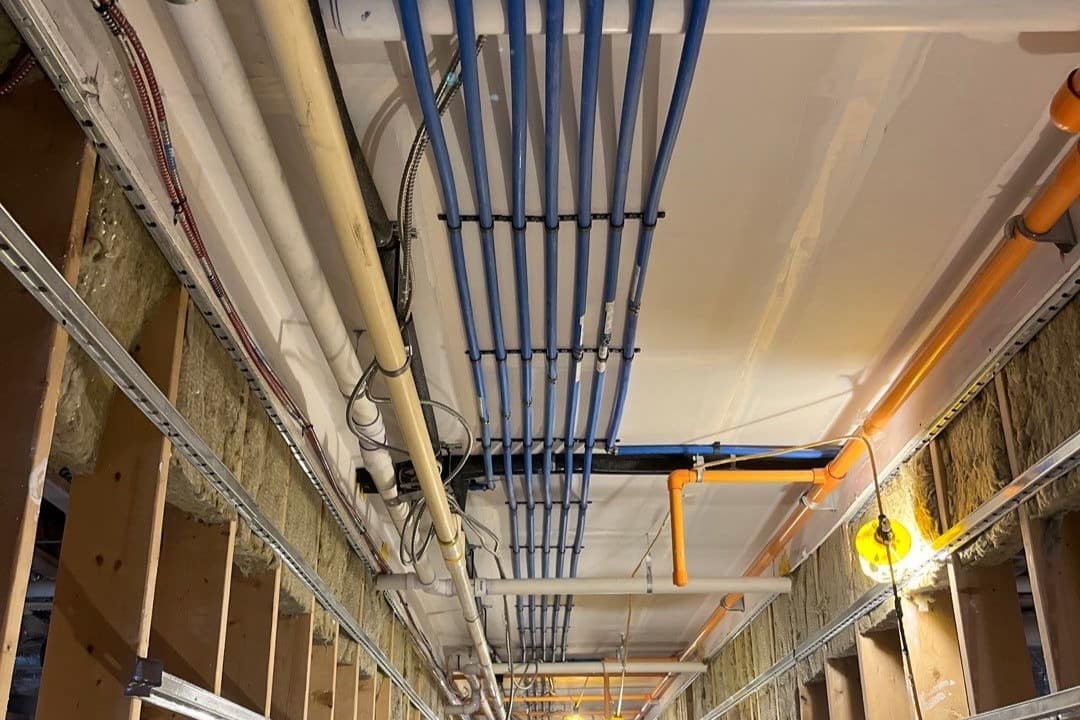Through the ages there have been many incarnations of the humble plumbing pipe. The ancients, right up until the 1900s, favored lead, not knowing about the health risks. Galvanized steel was once a popular choice before it was replaced by copper. Today, most installations use PEX for numerous reasons that we’ll get into. Here’s all you need to know about PEX pipe and why it might be right for your home plumbing needs.
What Is PEX Pipe?
At the most basic level, all you need to know about PEX pipe is that it’s a flexible, strong plastic solution to your domestic plumbing needs.
If you’re looking for a little more detail, PEX stands for cross-linked Polyethylene. It costs less than half the price of an equivalent amount of copper piping, weighs a lot less and can be installed even more quickly. Since it’s so flexible, it makes installation a breeze. It’s also resistant to freezing, scaling and corrosion-proof. It’s no wonder that it’s quickly becoming the go-to material for refits.
It was invented in 1968 by the German scientist Thomas Engle and first imported to the US around 1980. Since then, it’s slowly but surely gained market share, becoming the favored material for domestic plumbing installations.
Types of PEX Pipe
While that covers all you need to know about PEX pipe and why it’s becoming so popular, there is a little nuance to how it’s used. PEX comes in multiple different configurations, each with its own set of advantages.
PEX-A
PEX-A is highly flexible, making it a great choice for retrofitting existing buildings. It can be fed along existing pathways relatively easily, reducing the disruption in your refit. It’s also resistant to kinking and cracking and ideal for use in colder climates where freezing might be an issue.
PEX-B
While PEX-A is ideal for retrofitting, many plumbers prefer to use PEX-B in new builds. It’s a little more cost effective and just as strong (if not stronger) but less flexible. If accessibility isn’t a consideration, it’s an obvious way to save money without compromising on the advantages.
PEX-C
More affordable again than either PEX-A or PEX-B, PEX-C is super flexible, allowing longer runs with less fittings. It can be bent around corners fairly easily but on the down side, it’s less durable and can be prone to kinking. This makes it ideal for lighter applications but less suitable as your main supply pipework.
Advantages of PEX Pipe
While there’s a lot to recommend more traditional materials like copper, PEX pipe has numerous advantages that set it apart.
- Ease of Installation: PEX is flexible and lightweight, needing fewer fittings.
- Flexibility: Bending around corners makes installation even neater and easier.
- Cost-effectiveness: PEX is cheaper than even copper piping and requires less labor to install
- Durability: Being resistant to corrosion, freezing and mineral build-ups make PEX a long-lasting choice.
- Versatility: Whether you’re working on hot, cold or even radiant heating systems, PEX is suitable for a variety of tasks.
- Energy Efficiency: Plastic pipes like PEX retain heat better than their metal counterparts. This means that you lose less of the heat you’ve paid for through the walls of your plumbing.
Common Applications Of PEX Pipe
Now that we’ve covered all you need to know about PEX pipe and its advantages, how is this material harnessed around your home or business?
Residential Plumbing
If you live in a newer building or have recently remodeled, the chances are good that there is PEX piping in your home. It’s used for both hot and cold water distribution and in radiant heating. It’s flexibility, cost-effectiveness and ease of installation make it the most likely choice for newer builds and refits.
Radiant Floor Heating
Thanks to its fantastic heat-retention, PEX is a common choice for hydronic underfloor heating systems. It doesn’t lose much heat as it conducts the water around the home, making it ideal for ensuring an even distribution.
Commercial Plumbing
Being both flexible and cheap to buy and install, PEX is the obvious choice for larger installations. Many commercial settings have embraced the savings in both materials and labor costs and opted for PEX pipework.
Other Uses
PEX is also ideally suited for use in things like:
- Ice melting systems
- Snowmelt systems
- Municipal Water lines
As the older systems age out of practical use, they’re often replaced with more modern PEX pipes.
Installation Tips and Considerations
PEX is an easy material to work with, making it a popular choice amongst plumbers. There are two ways which PEX can be laid out in your home:
- Home-run systems with a manifold: These allow individualized water control for each section of your plumbing system but can be quite complex in terms of layout and design.
- Branch and Tee systems: These are a lot easier to layout and install.
PEX isn’t just flexible in terms of being able to twist around corners. It also allows a variety of fitting types to be harnessed. Crimps, cramps, push-fit or expansion fittings all allow PEX plumbing systems to be tailored to your particular needs.
Whichever you opt for, PEX tubing installation will require the right tools and fittings for the job at hand. These could include things like:
- Crimping tools
- Pipe cutters
Do’s and Don’ts
Installing PEX is pretty straightforward, especially with push-fit fittings. That being said, there are a few things to consider:
Avoid Exposure to UV light
One major weakness of PEX plumbing systems is their vulnerability to UV light. Over time, the sun’s rays will break down the material, causing failures. While this isn’t a problem for most installations, it does mean that PEX isn’t suitable for above-ground outdoor installations.
Ensure Proper Connections
It goes without saying that plumbing pipes need to be properly connected together to avoid leaks. PEX is no exception. If you’re working with a PEX installation, ensure that the joints are properly sealed. How this is achieved will depend on which fittings you’re using.
Follow Local Building Codes for PEX Piping
Your local authority will have set out rules for using PEX tubing in your home or business. Follow them. These have been put in place to ensure public safety and a good standard of installation that fits with local conditions.
Limitations of PEX Pipe
While the advantages of PEX are clearly evident, it’s not without its issues. Potential problems include:
- UV sensitivity: Exposed to sunlight for long enough, PEX begins to break down, leading to failures in exposed plumbing systems.
- Not recyclable: PEX unfortunately can’t be recycled yet. This creates concerns about its impact on the environment when it comes time to replace the system.
- Potential Rodent Damage: Rats and mice seem to enjoy chewing on PEX pipes. This leads to holes being bitten into them and potentially major leaks forming.
- Building Code Restrictions: Some areas may have additional limitations and requirements for PEX use. This could be down to some quirk of the local area or simply being slow to adapt the codes to newer materials.
Comparing PEX to Other Materials
While PEX installations are quickly becoming the standard across the US, thanks to its many advantages, other materials are still often worth considering.
PEX vs Copper
While PEX plumbing wins out on cost, corrosion-resistance, ease of installation and flexibility, copper still has its uses.
Copper is still relatively cheap (though often twice as expensive as PEX) and is hard to beat in terms of longevity. The main way it wins out over PEX though is in its resistance to UV light. This makes it the ideal choice for outdoor installations.
PEX vs PVC
PEX is flexible, cheap and durable, able to be harnessed into most plumbing solutions. Sometimes, this flexibility can actually be a drawback- for example, in drains where movement might exacerbate clogging.
PVC, another form of plastic pipework, is even cheaper than PEX is and has much greater levels of rigidity. While it’s not suitable for every purpose, it does work well for tasks where solidity is valued. It’s also a lot more resistant to the teeth of rodents, giving it a definite edge in one of PEX’s greatest weaknesses.
So, there you have it, all you need to know about PEX pipe. It’s strong, flexible, cheap and can be harnessed into use across your plumbing systems. When compared to the other options, it tends to win out in all but a few niche applications, making it the obvious choice.
Is it right for your project? Probably.

